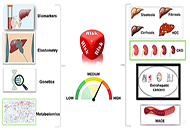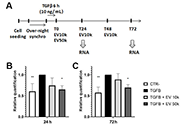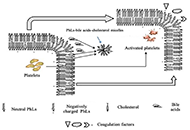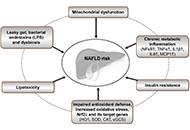Ultra-processed food consumption and the risk of non-alcoholic fatty liver disease—What are the proposed mechanisms?
A high consumption of ultra-processed food (UPF) is a hallmark of Western diets that has been related to increased risk of non-communicable diseases. As an underlying mechanism, UPF may promote non-
[...] Read more.
A high consumption of ultra-processed food (UPF) is a hallmark of Western diets that has been related to increased risk of non-communicable diseases. As an underlying mechanism, UPF may promote non-alcoholic fatty liver disease (NAFLD) which is a key driver of metabolic impairment with extra-hepatic manifestations like type 2 diabetes, cardiovascular disease, chronic kidney disease, and osteoporosis among others. The present review provides an overview of UPF properties that may promote NAFLD and are thus potential targets for reformulation of UPF. Such approaches should address improvements in the quality of carbohydrates and fat, changes in food texture that lower eating rate as well as ingredients that prevent excess caloric intake or avoid dysbiosis and leaky gut syndrome. Promising strategies are enrichment with fiber, prebiotics, phytochemicals, and protein with a concurrent reduction in glycemic load, energy density, saturated fatty acids (FA; SFA), emulsifiers, fructose, and non-caloric sweeteners. Future studies are needed to examine the interactive and protective effects of such modifications in the composition of UPF on prevention and treatment of NAFLD.
Franziska A. Hägele ... Anja Bosy-Westphal
A high consumption of ultra-processed food (UPF) is a hallmark of Western diets that has been related to increased risk of non-communicable diseases. As an underlying mechanism, UPF may promote non-alcoholic fatty liver disease (NAFLD) which is a key driver of metabolic impairment with extra-hepatic manifestations like type 2 diabetes, cardiovascular disease, chronic kidney disease, and osteoporosis among others. The present review provides an overview of UPF properties that may promote NAFLD and are thus potential targets for reformulation of UPF. Such approaches should address improvements in the quality of carbohydrates and fat, changes in food texture that lower eating rate as well as ingredients that prevent excess caloric intake or avoid dysbiosis and leaky gut syndrome. Promising strategies are enrichment with fiber, prebiotics, phytochemicals, and protein with a concurrent reduction in glycemic load, energy density, saturated fatty acids (FA; SFA), emulsifiers, fructose, and non-caloric sweeteners. Future studies are needed to examine the interactive and protective effects of such modifications in the composition of UPF on prevention and treatment of NAFLD.
 Principles of risk stratification in nonalcoholic fatty liver disease. A narrative review emphasizing non-invasive strategiesOpen AccessReviewNonalcoholic fatty liver disease (NAFLD) is an umbrella definition that describes the ectopic deposition of fat within the liver that occurs in the absence of inciting factors other than the metabol [...] Read more.Amedeo LonardoPublished: August 30, 2023 Explor Dig Dis. 2023;2:188–201
Principles of risk stratification in nonalcoholic fatty liver disease. A narrative review emphasizing non-invasive strategiesOpen AccessReviewNonalcoholic fatty liver disease (NAFLD) is an umbrella definition that describes the ectopic deposition of fat within the liver that occurs in the absence of inciting factors other than the metabol [...] Read more.Amedeo LonardoPublished: August 30, 2023 Explor Dig Dis. 2023;2:188–201 Human liver stem cell-derived extracellular vesicles modulate long non-coding RNA expression profile in an in vivo model of non-alcoholic steatohepatitisOpen AccessOriginal ArticleAim: Modifications in long non-coding RNA (lncRNA) expression are associated with inflammation and fibrosis in chronic liver diseases. It has been recently demonstrated that human liver stem cell [...] Read more.Giulia Chiabotto ... Stefania BrunoPublished: August 30, 2023 Explor Dig Dis. 2023;2:172–187
Human liver stem cell-derived extracellular vesicles modulate long non-coding RNA expression profile in an in vivo model of non-alcoholic steatohepatitisOpen AccessOriginal ArticleAim: Modifications in long non-coding RNA (lncRNA) expression are associated with inflammation and fibrosis in chronic liver diseases. It has been recently demonstrated that human liver stem cell [...] Read more.Giulia Chiabotto ... Stefania BrunoPublished: August 30, 2023 Explor Dig Dis. 2023;2:172–187 Pathophysiology of biochemical signs of primary biliary cholangitisOpen AccessReviewPrimary biliary cholangitis (PBC), previously known as primary biliary cirrhosis, is a rare chronic autoimmune cholestatic liver disease, affecting mostly females. With PBС develops chronic cholang [...] Read more.Vasiliy Ivanovich Reshetnyak, Igor Veniaminovich MaevPublished: August 27, 2023 Explor Dig Dis. 2023;2:149–171
Pathophysiology of biochemical signs of primary biliary cholangitisOpen AccessReviewPrimary biliary cholangitis (PBC), previously known as primary biliary cirrhosis, is a rare chronic autoimmune cholestatic liver disease, affecting mostly females. With PBС develops chronic cholang [...] Read more.Vasiliy Ivanovich Reshetnyak, Igor Veniaminovich MaevPublished: August 27, 2023 Explor Dig Dis. 2023;2:149–171 Ultra-processed food consumption and the risk of non-alcoholic fatty liver disease—What are the proposed mechanisms?Open AccessReviewA high consumption of ultra-processed food (UPF) is a hallmark of Western diets that has been related to increased risk of non-communicable diseases. As an underlying mechanism, UPF may promote non- [...] Read more.Franziska A. Hägele ... Anja Bosy-WestphalPublished: August 24, 2023 Explor Dig Dis. 2023;2:133–148
Ultra-processed food consumption and the risk of non-alcoholic fatty liver disease—What are the proposed mechanisms?Open AccessReviewA high consumption of ultra-processed food (UPF) is a hallmark of Western diets that has been related to increased risk of non-communicable diseases. As an underlying mechanism, UPF may promote non- [...] Read more.Franziska A. Hägele ... Anja Bosy-WestphalPublished: August 24, 2023 Explor Dig Dis. 2023;2:133–148